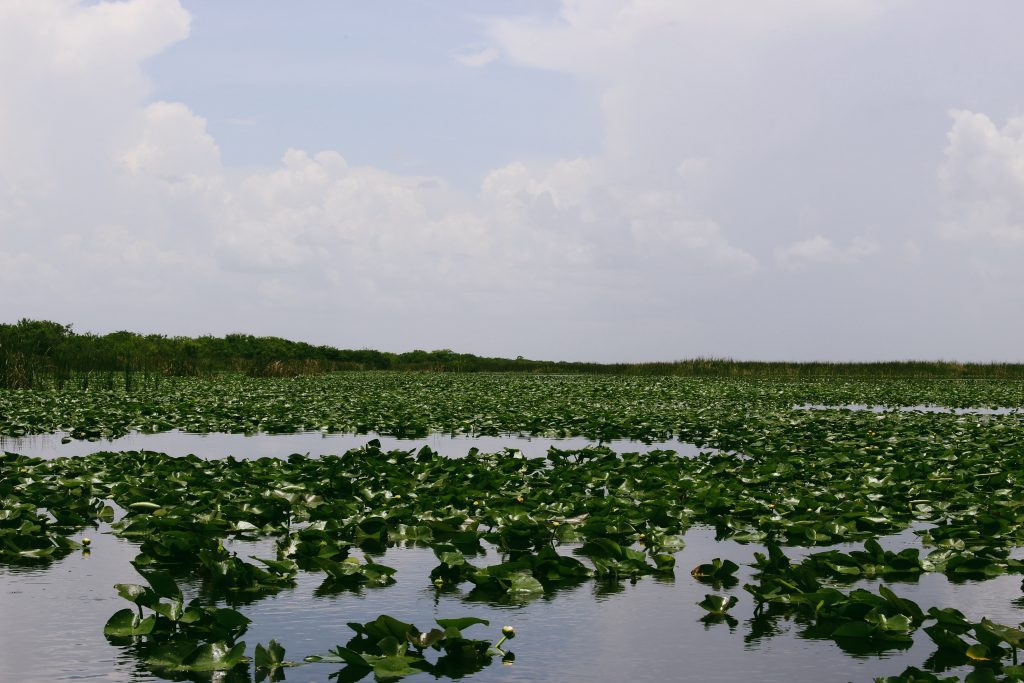The Florida Everglades, a vast ecosystem that nearly covered 11,000 square miles1 of Southern Florida, was given another chance when the Biden administration granted $1.1 billion of a $14 billion bipartisan infrastructure bill 7 towards its restoration. At over a billion dollars, it is the largest single investment in the Everglades7. This funding is part of a larger bill with a goal to “increase climate resilience and make improvements at ports and waterways”6. Today, the Florida Everglades is famed as a national park, tourist attraction, and haven to birders, however, the ecosystem has a rich history and is more essential to Florida than meets the eye.
History
Hundreds of years ago, water stretched from Lake Okeechobee, nearly double its present-day size, to South Florida2. In this environment thrived various groups of Native peoples, who settled in nearby villages and traveled to the Everglades to hunt and fish2. Some of the most notable tribes were the Seminoles and Miccosukee’s, who settled on tree islands and traded alligator hides and egret feathers2. To this day, the Miccosukee tribe continues to utilize the Everglades for subsistence and rituals, with control of over 189,000 acres of the management area in a perpetual lease2.
In the early 1900s, the Everglades were forever changed when drainage projects damaged the ecosystem to make way for farmland and communities1. In 1947, to protect the environment from further degradation, the Everglades was established as a national park1.

Value / Importance
Not only is the Everglades a massive ecosystem covering a large portion of the state of Florida, but the Everglades plays a massive role for people and wildlife alike. The Everglades, which is both the largest wilderness in the eastern United States, and largest subtropical wilderness, is home to threatened and endangered species such as the Florida panther, American crocodile, and wood stork4 While supporting wildlife and plant life, the Everglades supports the “natural heritage, culture, and economy of Florida and the Nation”4. For locals, the Everglades is the source of drinking water for approximately 8 million Floridians, and also protects those communities from natural disasters such as hurricanes and floods5.In addition, the Everglades generates over $150 million in annual spending, and supports a $1.2 billion fishing industry5.

Restoration Efforts
Following the establishment of Everglades National Park, the Congressional Central and South Florida project was enacted to further protect the ecosystem from flooding while also establishing a source of fresh water for residents. The project established three water conservation areas, including the Everglades and the Francis S. Taylor Wildlife Management Area2. However, the project had a lot of negative impacts on the ecosystem. As water control structures and roads, such as the iconic Tamiami Trail were constructed, natural hydro-periods and sheet flow were disrupted2. The 1994 Everglades Forever Act was introduced to address these concerns over water2. At its time, this project was the most expensive and comprehensive restoration project in history3.
In addition to this landmark project, there are several other efforts in place to protect and conserve the Everglades. Agricultural runoff is a major threat to the Everglades. Since the 1960s, the water quality of the Everglades has continually been degraded do to increased phosphorous content from agricultural runoff4. Increased phosphorous content is devastating as it reduces natural algae communities, as well as reduced available oxygen in water required by fish to survive4. To address issues of agricultural runoff, local farmers must abide by best management practices, which aim to reduce phosphorous content in water before the water leaves the farm4.
Since the 2000s, the Everglades has been home to a population of Burmese python, a non-native species that was introduced to the ecosystem3. Without natural predators, the Burmese python population has increased exponentially, affecting populations of native species such as white-tailed deer and raccoons3. Since the proliferation of Burmese python, rabbits are no longer being spotted in the Everglades. To address the issue, Florida Fish and Wildlife encourages the public to humanely dispatch pythons regardless of hunting license8.
The 2000 Comprehensive Everglades Restoration Plan (CERP) was established to “restore, protect, and preserve the resilience of the Everglades” 5. To accomplish this, the plan lays out 68 components aimed at restoring natural flows and treating Okeechobee’s overflow5.
Sources
- “Everglades: History & Culture”. National Parks Service, 14 April 2015. https://www.nps.gov/ever/learn/historyculture/index.htm
- “Everglades – History”. Florida Fish and Wildlife Commission, 2022. https://myfwc.com/recreation/lead/everglades/history/
- “Learn About Everglades National Park”. Florida National Parks Association, 2022. https://floridanationalparksassociation.com/learn-about-everglades-national-park
- “Why is it Important to Restore the Everglades?”. United States Environmental Protection Agency, 2022. https://www.epa.gov/everglades/why-it-important-restore-everglades
- “Protecting the Everglades”. National Wildlife Federation, 2022. https://www.nwf.org/Our- Work/Waters/Great-Waters-Restoration/Everglades
- “FACT SHEET: Biden-Harris Administration Announces Historic Investment to America’s Port and Waterway Infrastructure”. The White House, 19 January 2022. https://www.whitehouse.gov/briefing-room/statements-releases/2022/01/19/fact- sheet-biden-harris-administration-announces-historic-investment-to-americas-port-and- waterway-infrastructure/
- “An Unprecedented Investment in Everglades Restoration and a Giant Step Forward in Climate Resiliency”. Audubon Florida, 19 January 2022. https://fl.audubon.org/news/unprecedented-investment-everglades-restoration-and- giant- step-forward-climate-resiliency
- “Removing Pythons in Florida”. Florida Fish and Wildlife Conservation Commission, 2022. https://myfwc.com/wildlifehabitats/nonnatives/python/removing/








